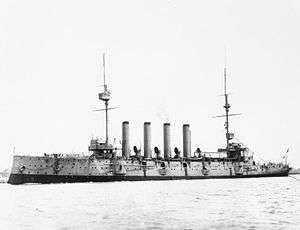HMS Ariadne (1898)
HMS Ariadne was a Diadem-class protected cruiser of the Royal Navy, which was launched in 1898, In March 1913, she was converted to a stokers' training ship and in 1917 was converted to a minelayer and assigned to the Nore Command. She was torpedoed and sunk off Beachy Head by the German submarine UC-65 (Otto Steinbrinck) on 26 July 1917.
 HMS Ariadne | |
| History | |
|---|---|
| Name: | HMS Ariadne |
| Builder: | J&G Thompson, Clydebank |
| Launched: | 22 April 1898 |
| Christened: | Lady Balfour of Burleigh |
| Reclassified: | Minelayer, March 1917 |
| Fate: | Sunk by UC-65, 26 July 1917 |
| General characteristics | |
| Class and type: | Diadem-class protected cruiser |
| Displacement: | 11,000 long tons (11,000 t) |
| Length: |
|
| Beam: | 69 ft (21 m) |
| Draught: | 25 ft 6 in (7.77 m) |
| Installed power: | 16,500–18,000 ihp (12,300–13,400 kW) |
| Propulsion: |
|
| Speed: | 20–20.5 knots (37.0–38.0 km/h; 23.0–23.6 mph) |
| Complement: | 760 |
| Armament: |
|
| Armour: | |

Service history
Ariadne was built by J&G Thompson of Clydebank and launched on 22 April 1898, when she was named by Lady Balfour of Burleigh, wife of Lord Balfour of Burleigh, who served as Secretary of State for Scotland.[1]
In March 1902 she was ordered to prepare for service on the North America and West Indies Station, where she would act as flagship to Vice-Admiral Sir Archibald L. Douglas when he took up command on the station in July that year.[2] She was commissioned at Portsmouth on 5 June 1902 by Captain Montague Browning, who was appointed flag captain in command of the ship from the same day.[3][4] Leaving Portsmouth in early July,[5] she arrived at the station headquarters at Halifax and formally succeed HMS Crescent as flagship to the station on 15 July.[6] In August–September 1902 she visited St Johns, Newfoundland, Quebec City and Charlottetown.[7][8] In November the same year, she visited the Bermuda headquarters of the station.[9]
Notes
- "Naval & Military intelligence". The Times (35498). London. 23 April 1898. p. 12.
- "Naval & Military intelligence". The Times (36724). London. 25 March 1902. p. 9.
- "Naval & Military intelligence". The Times (36787). London. 6 June 1902. p. 11.
- "Naval & Military intelligence". The Times (36754). London. 29 April 1902. p. 7.
- "Naval & Military intelligence". The Times (36811). London. 4 July 1902. p. 8.
- "Naval & Military intelligence". The Times (36822). London. 17 July 1902. p. 9.
- "Naval & Military intelligence". The Times (36845). London. 13 August 1902. p. 8.
- "Naval & Military intelligence". The Times (36863). London. 3 September 1902. p. 4.
- "Naval & Military intelligence". The Times (36912). London. 30 October 1902. p. 10.
References
- Colledge, J. J.; Warlow, Ben (2006) [1969]. Ships of the Royal Navy: The Complete Record of all Fighting Ships of the Royal Navy (Rev. ed.). London: Chatham Publishing. ISBN 978-1-86176-281-8.
- Diadem class at worldwar1.co.uk
| Wikimedia Commons has media related to HMS Ariadne (ship, 1898). |